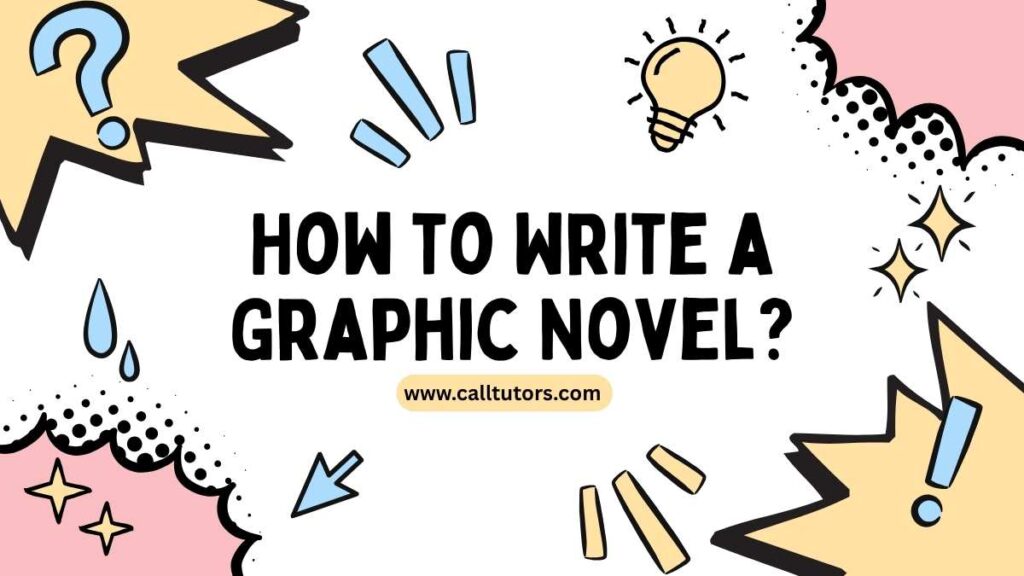Graphic novels have become one of the most engaging and creative ways to tell stories. From memoirs to science fiction, and everything in between, these illustrated narratives captivate readers with a unique blend of visual art and written word. In recent years, graphic novels have surged in popularity across all age groups, bridging the gap between traditional literature and visual storytelling. They offer an immersive reading experience, where emotion, action, and dialogue leap off the page—not just through words, but through striking visuals and expressive panel layouts. In this guide, we’ll learn each step of how to write a Graphic Novel, from idea generation to publication.
Step-by-Step Guide on How to Write a Graphic Novel
Table of Contents
Step 1: Develop Your Story Idea.
Every great graphic novel begins with a compelling story idea. Think about what kind of story you want to tell. Is it a superhero saga, a historical drama, a coming-of-age tale, or a fantastical adventure? Start with brainstorming themes and genres that excite you.
Next, identify your target audience. Writing for children, teens, or adults will influence your tone, content, and visuals. Ask yourself: What message do I want to convey? What emotion should readers feel after finishing my story?
Additionally, do some research on current graphic novel trends. Understanding what’s popular—and what’s missing—can help you carve out a unique niche. Read widely within the genre, take notes on what works, and begin imagining how your story will stand out in a crowded market.
Step 2: Create Compelling Characters.
Characters are the heart of any story. To write a successful graphic novel, you need well-developed, relatable characters. Begin with your protagonist and antagonist. What do they want? What drives them? How do they change throughout the story?
Give your characters distinct personalities, appearances, and backstories. Visual storytelling demands that characters are easily recognizable and expressive. Sketch or describe how they look, speak, and react to situations. This step is crucial, as readers connect deeply with characters who feel real and multidimensional.
Include supporting characters who add depth to the narrative. Each character should have a clear role in the story and contribute to the main character’s journey. Dynamic character interactions and relationships are often the emotional glue that holds a graphic novel together.
Step 3: Outline the Plot.
Once you have your characters and concept, it’s time to structure your story. Most graphic novels follow a narrative arc: a beginning (setup), middle (conflict), and end (resolution).
Here are a few classic storytelling structures to consider:
- Three-act structure: Introduction, confrontation, resolution
- Hero’s journey: A character embarks on an adventure, faces a crisis, and returns transformed
- In medias res: Start the story in the middle of action to hook readers quickly
Create a scene-by-scene breakdown to ensure logical progression. This outline acts as your roadmap, keeping the story cohesive and focused.
You can also use beat sheets or chapter outlines to segment your story into manageable parts. Graphic novels can range from 60 to 300 pages or more, so planning helps maintain a balanced narrative and pacing.
Step 4: Write the Script.
Writing a graphic novel script is similar to writing a screenplay. You’ll describe the action in each panel and write the dialogue that appears in speech bubbles or captions.
A sample script might look like this:
Page 1, Panel 1: (INT. BEDROOM – NIGHT) A teenage girl sits on her bed, staring at a glowing object in her hands.
GIRL (caption): “It all started with this one mysterious thing.”
Keep your descriptions clear and concise, focusing on what the artist needs to draw. Avoid overloading panels with dialogue. Less is more in visual storytelling.
Use capital letters to distinguish between panel descriptions and dialogue. This format is industry standard and helps when collaborating with artists or editors. Remember to balance narration with visual cues, and keep the reader’s eye moving naturally through the page.
Step 5: Design the Layout
Panel. Layout and page composition are fundamental to pacing and reader engagement. You don’t have to be an artist to understand basic layout principles.
Decide how many panels will be on each page. Use larger panels for dramatic moments and smaller ones for fast-paced sequences. Vary panel sizes and shapes to create rhythm and visual interest.
Think about page turns and how to end each page with something that makes the reader want to continue. This is where your storyboard or thumbnail sketches can come in handy.
Pay attention to the visual flow—make sure the reader’s eyes are drawn smoothly from one panel to the next. Consider the balance of text and images; white space and silence can be powerful tools in setting tone and mood.
Step 6: Collaborate with an Artist (If You’re Not One)
If you’re not illustrating your graphic novel yourself, you’ll need to collaborate with an artist. Look for someone whose style aligns with your story. Platforms like DeviantArt, Behance, or comic forums are great places to find collaborators.
Create a clear agreement regarding deadlines, ownership, and compensation. Communication is key. Share your script, character designs, and visual references to help the artist bring your vision to life.
You can also consider working with a colorist and letterer if your artist doesn’t provide those services. These roles contribute significantly to the final look and readability of your graphic novel.
Step 7: Edit and Revise.
Editing a graphic novel involves both the text and the visuals. Once the initial draft is complete, review the flow of panels, the clarity of the story, and the quality of artwork.
Ask for feedback from beta readers, editors, or fellow creators. Be open to suggestions and ready to make revisions. Sometimes, a small visual change or dialogue tweak can enhance the impact of a scene.
Also, check for consistency in character design, speech bubbles, and lettering. Proofreading is just as important in graphic novels as it is in traditional books.
Print a test copy to review how everything looks in physical form. This can reveal layout or resolution issues that are not noticeable on the screen.
Step 8: Publish Your Graphic Novel.
Now comes the exciting part: publishing. You can go the traditional route by submitting your work to graphic novel publishers, or opt for self-publishing.
Traditional Publishing:
- Research publishers that accept unsolicited graphic novel submissions
- Prepare a professional pitch: synopsis, sample pages, and bio
- Be patient with the process and open to editorial guidance
Self-Publishing Options:
- Print-on-demand services like Amazon KDP, IngramSpark
- Digital platforms like Webtoon, Tapas, or Gumroad
- Crowdfunding on Kickstarter or Indiegogo
Marketing is essential for both routes. Build an online presence through social media, author websites, and communities. Engage with readers and promote your work through sneak peeks, behind-the-scenes content, and launch events.
Don’t forget to attend comic conventions and festivals. These are great places to showcase your work, network with industry professionals, and connect with fans.
Conclusion:
Learning how to write a graphic novel is a thrilling, creative journey. From dreaming up original ideas to seeing your illustrated story come to life, each step offers its rewards. Whether you’re working alone or with a team, remember that persistence and passion are your greatest tools.
Start small, stay consistent, and don’t be afraid to try new things. Your story deserves to be told—and there’s a world of readers waiting to see it in pictures and words. So pick up that pen (or stylus) and begin your graphic novel adventure today!



